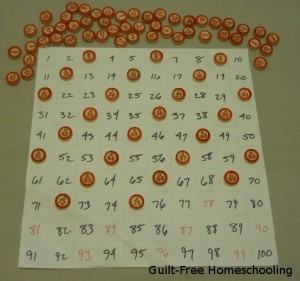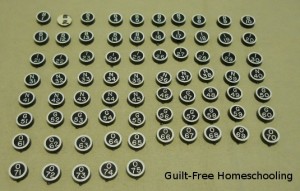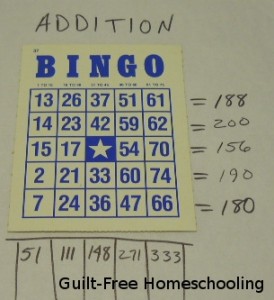A standard Bingo game contains several printed cards with numbers arranged into a grid of rows and columns and tokens marked B-1 through O-75, used for calling the numbers when playing the game. These components can be used in other ways for some creative (and fun) variations on math practice.
- Play Bingo for number recognition practice and good, clean fun.
- Sort the number-tokens into odds and evens. Or sort out just the tokens needed to skip-count by 2’s, or 3’s, or 4’s, etc.

- Arrange the tokens into numerical order from 1-75.

- Sort the tokens into 1-10, 11-20, etc.
- Pick 2 (or more) tokens at random and add their values together. Now try subtracting them, multiplying them, or dividing them. [Hint: Place all of the tokens into a paper sack or a clean sock for ease of random drawing.]
- Pick 2 tokens at random and make fractions from their numbers — make both a proper fraction (numerator is smaller than denominator) and an improper fraction (numerator is larger than denominator). Simplify each fraction, if possible, or make a list of equivalent fractions.

- Add the columns of numbers on the Bingo cards.

- Add the rows of numbers on the Bingo cards.
- Write the factors for each number on a Bingo card or for number tokens drawn at random.
- Practice rounding with the numbers on the Bingo cards or with randomly drawn tokens.


 Guilt-Free Homeschooling is the creation of Carolyn Morrison and her daughter, Jennifer Leonhard. After serious disappointments with public school, Carolyn spent the next 11 years homeschooling her two children, from elementary to high school graduation and college admission. Refusing to force new homeschooling families to re-invent the wheel, Carolyn and Jennifer now share their encouragement, support, tips, and tricks, filling their blog with "all the answers we were looking for as a new-to-homeschooling family" and making this website a valuable resource for parents, not just a daily journal. Guilt-Free Homeschooling -- Equipping Parents for Homeschooling Success!
Guilt-Free Homeschooling is the creation of Carolyn Morrison and her daughter, Jennifer Leonhard. After serious disappointments with public school, Carolyn spent the next 11 years homeschooling her two children, from elementary to high school graduation and college admission. Refusing to force new homeschooling families to re-invent the wheel, Carolyn and Jennifer now share their encouragement, support, tips, and tricks, filling their blog with "all the answers we were looking for as a new-to-homeschooling family" and making this website a valuable resource for parents, not just a daily journal. Guilt-Free Homeschooling -- Equipping Parents for Homeschooling Success!

Thank you for the great ideas!!